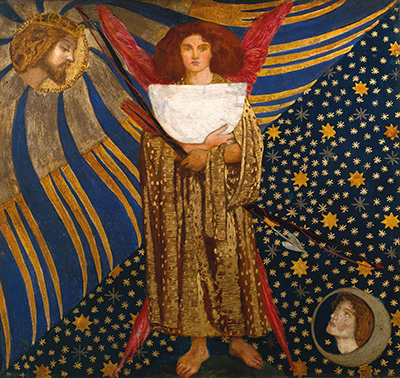Dantis Amor (1860) by Dante Gabriel Rossetti has been hanging in the Tate, London, for the last 100 years. The painting is one of three that were panels decorating cupboard doors above a settle (a settle is a large high backed wooden bench akin to a church pew).
Dantis Amor was the painting in the middle panel. The subject's name is Beatrice Portinari, familiar to those who know the work of the Italian poet Dante Alighieri. She was the muse in his 1294 book, Vita Nouva. In real life, she was Simone dei Bardi, the daughter of a friend. The panel to the left was The Salutation of Beatrice in Florence and the panel on the right was The Salutation in the Garden of Eden. Both survive, albeit not at the Tate.
The painting is said to show Beatrice's death. In the top left of the painting is Christ, waiting for her. Rich, stylised sun rays beam out from behind him. The central figure isn't Beatrice, rather an angel. The angel is said to represent love. Beatrice is in the bottom right-hand corner, surrounded by the moon. The angel is holding an incomplete sundial. The story is that the sundial was meant to be set at nine, that number representing the hour of Beatrice's death, at which time she would be united with Christ. Studies have revealed that the painting was completed in layers. The sun's rays and field of stars in the bottom corner were painted first, then Christ and Beatrice. Finally, the Angel was painted in. The angel, as befitting someone representing love, is richly dressed in golds and browns.
Dantis Amor is an oil painting on mahogany. It harks back to medieval Italy and the painting is representative of that time - rich, heavy, realistic and stylised. Dante Rossetti paintings are typically rich in sensuality and medieval revivalism. Dantis Amor is no exception. Areas of the painting are incomplete, for example, the sundial and the crescent around Beatrice. There is a theory, yet unproven, that another artist was involved in the painting. Dantis Amor was in private hands until 1920. For much of the 19th century, it belonged to the Morris Family. It passed to F.Treharne James who donated it to the Tate in 1920 where it hangs as an enduring masterpiece depicting medieval love and obsession.




